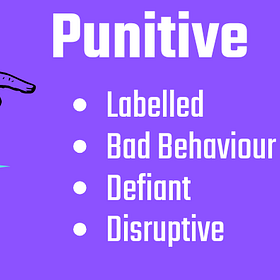❤️🩹 The Power of a Soft Landing: A Gentle Start for a Better Day
What Is a Soft Landing in Schools? A Morning Strategy to Support SEMH and Neurodiverse Pupils
👋 Welcome to SEMH Education!
Every week, I share insights, strategies, and tips from my experience working with children and professionals on social, emotional, and mental health (SEMH) in education. This week, we’re exploring what a soft-start really is and how you can implement them for children who struggle in a morning!
Let me know you’re here! Clicking the ♥️ button or pressing the ‘L’ key on your keyboard shows me you’re here and enjoying my content 😊.
🌞 A Soft Start with a Big Impact
Imagine walking into your workplace and being greeted with your favourite hot drink, a calm playlist, and colleagues who check in quietly about how you’re doing, not what you’re doing.
Now imagine being thrust into a high-pressure meeting with no warm-up, no warning, no space to breathe. Which version helps you do your best work?
This is the thinking behind the soft landing, a simple yet transformative strategy that gives children, especially those with SEMH needs, the best chance of success each day.
🚦 What Is a Soft Landing?
A soft landing refers to a structured, calm, and welcoming start to the school day. It allows pupils time to transition from the often unpredictable chaos of the outside world into the safety and structure of school.
For children with SEMH needs, this kind of transition is critical. The school gate might follow a morning of dysregulation: a missed breakfast, conflict at home, overstimulation on public transport, or underlying anxiety about the day ahead. A soft landing recognises that emotional readiness comes before academic readiness.
Do you use soft landings in your setting already? Let me know what they look like! 👇
🌪️ Why It Matters
Children with SEMH needs often live in a heightened state of alert or anxiety. Neurodiverse pupils, those with attachment needs, and those exposed to trauma may experience mornings as especially overwhelming.
Without a buffer, they arrive dysregulated and are quickly expected to sit still, listen, and complete tasks, setting them up to fail. The result is often escalated behaviours, missed learning, and increased likelihood of Off-Site Direction, managed moves or exclusions.
If you’re interested in understanding off-site directions, managed moves and permanent exclusions more, take a look at this post here.
The DfE’s Behaviour in Schools guidance (February 2024), reminds schools to take early preventative action before exclusions are considered. A well-designed soft landing is one such intervention that aligns with this requirement.
🏫 What It Can Look Like (Whole-Class Example)
Soft landings aren’t just for a few pupils, they can support everyone when integrated as a universal provision. You may not be able to incorporate all of these at once. These are just some prompts which might help you think of ideas which could be used in your setting:
Breakfast available on arrival: a selection of cereals, bagels, juice or tea. No questions asked.
Sensory-friendly media playing: football highlights, marble races, “oddly satisfying” videos, or age-appropriate trailers.
Discrete register: no shouting across the classroom; names ticked off quietly as pupils settle.
15–30 minutes of ‘chilled time’: drawing, puzzles, soft music, social games, or quiet chats.
Staff check-ins: a quick, informal chat with each pupil, especially those you need to follow up with from the day before.
Collaborative planning: once everyone’s settled, pupils decide the order of lessons using a visual timetable. This builds autonomy and engagement.
Final transition: finish the video or game, confirm everyone’s ready, and move into the first lesson.
✏️ Practical Tips to Implement Soft Landings
✅ Start small: Trial in one classroom or with a targeted group. Gather feedback before scaling.
✅ Use pupil voice: Ask what helps them feel calm and ready. Build your plan around their input.
✅ Protect the time: Make it non-negotiable. Don’t let admin or academic pressures eat into it.
✅ Staff consistency: Ensure the same adults are there to greet pupils each morning. This builds trust.
✅ Visual cues: Use visual timetables, timers, or “ready to learn” checklists to help signal transitions.
🤔 Takeaway: Regulate First, Educate Second
Soft landings are a simple but powerful reminder that emotional safety is the foundation for academic success. When we create predictable, nurturing spaces at the start of the day, we set a tone of trust, connection, and calm.
For pupils with SEMH needs, this isn’t just a nice extra, it’s an essential lifeline.
Let’s start the day as we mean to go on: connected, calm, and ready to learn.
📬 Did You Miss These?
How to Really Build Effective Communication With Parents
I’ve previously posted about the importance of parents/carers in education here. They are a key pillar of support for children engaging in education. Having them as part of the child’s support network for education can result in children soaring academically. Parents/carers play a vital role in consolidating the learning and behaviours that take place i…
Reframing 'Bad Behaviour': The Power of Strength-Based Approaches
In my experience, ‘bad behaviour’ displayed by children, especially those with SEN and/or Trauma, is very rarely a choice. There is usually an underlying trigger which has prompted their behaviour. This may be something small, such as misunderstanding an instruction, or something more significant, such as not having anything to eat and not being able to…
Top 5 SEMH Tips
Supporting children and young people with Social, Emotional, and Mental Health (SEMH) needs can be highly challenging. Throughout my career, I’ve developed various strategies to help these individuals thrive. However, due to the nature of their needs, approaches that work well one week or month may lose effectiveness, requiring constant adaptation and c…






Terrific insights and practical ideas, thank you!